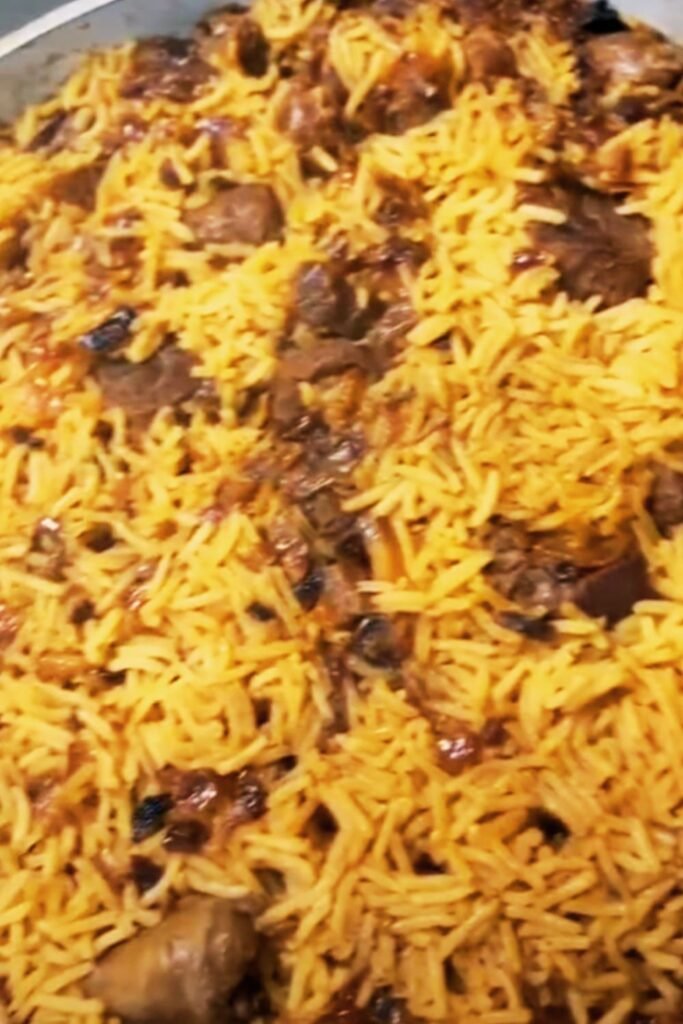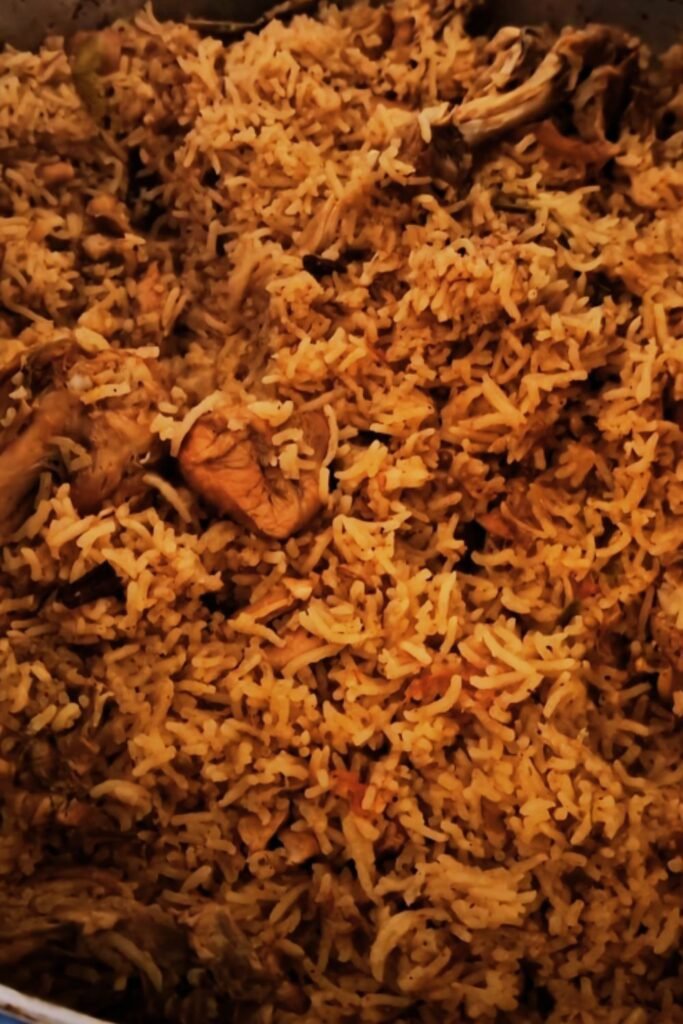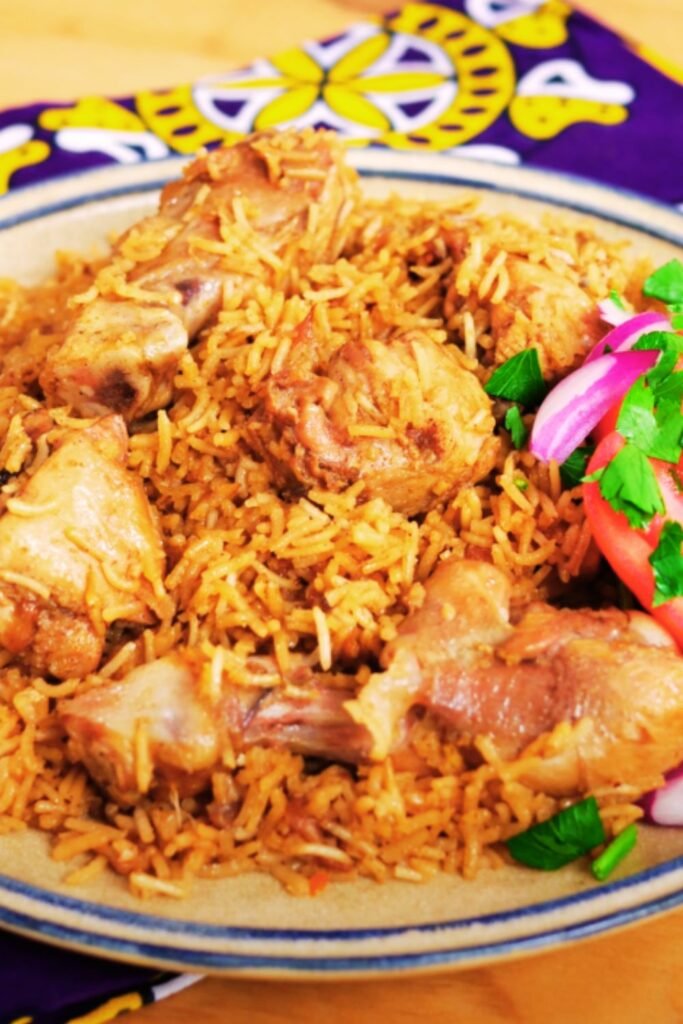There’s something truly magical about the aroma of spices filling my kitchen when I’m preparing Chicken Dupiaza. This beloved Pakistani and Indian dish, also known as Dopiaza, literally translates to “double onion” – a testament to the generous amount of onions that create its distinctive flavor profile. What makes this recipe particularly special is how I’ve adapted it for those following a slimming-friendly approach without compromising on taste or authenticity.
I’ve been perfecting this recipe for years, and I can confidently say that this version delivers all the rich, complex flavors you’d expect from a traditional Chicken Dupiaza while keeping it lighter and more nutritious. The combination of tender chicken pieces swimming in a aromatic gravy, paired with fragrant pilau rice, creates a meal that’s both satisfying and guilt-free.
The beauty of Chicken Dupiaza lies in its simplicity and depth. While the ingredient list might seem extensive, each spice plays a crucial role in building layers of flavor. The dish gets its name from the way onions are used in two different stages – first as a base for the curry, and then added again towards the end for texture and sweetness.
Understanding Chicken Dupiaza: A Culinary Journey
Dupiaza (also spelled Dopiaza): A cooking technique and dish name derived from the Persian words “do” meaning two and “piaza” meaning onion. This method involves cooking onions at two different stages of the cooking process.
Garam Masala: A warm spice blend typically containing cinnamon, cardamom, cloves, cumin, coriander, nutmeg, and bay leaves. The exact composition varies by region and family tradition.
Pilau Rice: A fragrant rice dish where the grains are first sautéed in oil or ghee before being cooked in seasoned broth, resulting in separate, fluffy grains with enhanced flavor.
Tempering (Tadka): The technique of heating spices in oil to release their essential oils and maximize flavor impact.
This dish originates from the Mughal cuisine tradition, where the double-onion technique was developed to create depth and complexity in curries. What I love about making Chicken Dupiaza is how it teaches you fundamental cooking techniques that you can apply to countless other dishes.
The Health Benefits of My Slimming Version
When I first started adapting traditional recipes for healthier eating, I was determined not to sacrifice flavor. My version of Chicken Dupiaza proves that you can enjoy rich, satisfying curries while maintaining your health goals.
I use skinless chicken pieces to reduce saturated fat content while maintaining high-quality protein. The abundance of onions provides quercetin, a powerful antioxidant with anti-inflammatory properties. The spice blend I use isn’t just about flavor – turmeric offers curcumin’s anti-inflammatory benefits, while cumin aids digestion and metabolism.

The pilau rice accompaniment uses less oil than traditional preparations, and I often substitute brown rice for additional fiber and nutrients. This combination creates a balanced meal that provides sustained energy without the heavy feeling often associated with restaurant curries.
Essential Ingredients and Their Roles
For the Chicken Dupiaza
| Ingredient | Quantity | Purpose | Slimming Benefits |
|---|---|---|---|
| Chicken breast (skinless) | 800g, cut into chunks | Main protein source | High protein, low fat |
| Large onions | 3 medium, sliced | Flavor base and texture | High fiber, natural sweetness |
| Tomatoes | 2 large, chopped | Acidity and body | Lycopene, vitamin C |
| Greek yogurt (0% fat) | 150ml | Tenderizing and creaminess | Probiotics, protein |
| Fresh ginger | 2-inch piece, minced | Warmth and digestive aid | Anti-inflammatory |
| Garlic cloves | 6, minced | Aromatic base | Immune support |
| Green chilies | 2, slit lengthwise | Heat and freshness | Metabolism boost |
| Fresh coriander | Large bunch, chopped | Garnish and flavor | Vitamins A, C, K |
Spice Blend
| Spice | Quantity | Flavor Profile | Health Benefits |
|---|---|---|---|
| Ground turmeric | 1 tsp | Earthy, warm | Anti-inflammatory |
| Ground cumin | 2 tsp | Nutty, smoky | Digestive aid |
| Ground coriander | 2 tsp | Citrusy, sweet | Antioxidant |
| Garam masala | 1 tsp | Complex, warming | Circulation boost |
| Red chili powder | 1 tsp (adjust to taste) | Heat, color | Metabolism support |
| Bay leaves | 2 whole | Subtle, aromatic | Digestive properties |
For the Pilau Rice
| Ingredient | Quantity | Purpose | Nutritional Value |
|---|---|---|---|
| Basmati rice | 300g | Base grain | Complex carbohydrates |
| Chicken stock (low sodium) | 500ml | Flavor enhancement | Protein, minerals |
| Whole spices (cardamom, cinnamon, cloves) | As specified | Aromatic flavoring | Antioxidants |
| Light olive oil | 1 tbsp | Cooking medium | Healthy fats |
| Salt | To taste | Seasoning | Mineral balance |
Step-by-Step Cooking Method
Preparing the Chicken Dupiaza
My approach to this dish involves building flavors layer by layer. I always start by marinating the chicken, which ensures tender, flavorful meat throughout.
Marinating the Chicken:
- Combine chicken pieces with half the yogurt, minced ginger, garlic, turmeric, and salt
- Let this marinate for at least 30 minutes (I prefer 2 hours when time permits)
- The yogurt’s enzymes break down proteins, resulting in incredibly tender chicken
Creating the Base:
- Heat a non-stick pan over medium heat with minimal oil
- Add bay leaves and let them release their aroma
- Introduce half the sliced onions and cook until golden brown
- This first batch of onions forms the flavor foundation
The key to authentic Dupiaza lies in patience. I cook the first batch of onions until they’re deeply caramelized, which can take 15-20 minutes. This patience pays off in the complex sweetness that defines the dish.
Building the Curry:
- Add the remaining ginger-garlic paste to the caramelized onions
- Incorporate tomatoes and cook until they break down completely
- Add all the ground spices and cook for 2-3 minutes until fragrant
- Introduce the marinated chicken along with any marinade

I find that cooking the spices properly at this stage prevents any raw, bitter flavors in the final dish. The tomatoes should completely break down, creating a thick, rich base that coats the chicken beautifully.
The Double Onion Technique:
- After the chicken is nearly cooked (about 20 minutes), add the remaining sliced onions
- These second onions provide texture and a fresh onion flavor contrast
- Cook for another 10-15 minutes until chicken is fully cooked and sauce thickened
Preparing the Perfect Pilau Rice
Pilau rice elevates this meal from good to extraordinary. My method ensures each grain is separate and perfectly seasoned.
Rice Preparation Steps:
- Rinse basmati rice until water runs clear
- Soak for 30 minutes to ensure even cooking
- Heat oil in a heavy-bottomed pan
- Add whole spices (2 cardamom pods, 1 cinnamon stick, 3 cloves)
- Add drained rice and sauté for 2-3 minutes
- Pour in hot stock and add salt
- Bring to boil, then reduce heat to lowest setting
- Cover and cook for 12 minutes exactly
- Let rest off heat for 10 minutes before fluffing
The soaking step is crucial – it prevents the rice from breaking during cooking and ensures uniform texture. I always use a 1:1.7 ratio of rice to liquid for perfect results.
Nutritional Analysis and Portion Control
Understanding the nutritional profile of this dish helps with meal planning and portion control. My slimming version significantly reduces calories while maintaining nutritional value.
Nutritional Breakdown (Per Serving, Serves 4)
| Nutrient | Amount | % Daily Value | Benefits |
|---|---|---|---|
| Calories | 485 | 24% | Moderate caloric load |
| Protein | 42g | 84% | Muscle maintenance |
| Carbohydrates | 58g | 19% | Energy provision |
| Fiber | 4.2g | 17% | Digestive health |
| Fat | 8.5g | 13% | Essential fatty acids |
| Sodium | 580mg | 25% | Electrolyte balance |
| Iron | 3.2mg | 18% | Oxygen transport |
| Vitamin C | 25mg | 28% | Immune support |
Comparison with Traditional Version
| Aspect | Traditional | My Slimming Version | Reduction |
|---|---|---|---|
| Calories per serving | 750-850 | 485 | 35-43% |
| Fat content | 25-30g | 8.5g | 65-72% |
| Saturated fat | 12-15g | 2.1g | 80-86% |
| Sodium | 900-1200mg | 580mg | 35-52% |
The reduction in calories comes primarily from using skinless chicken, reducing oil, using fat-free yogurt, and controlling portion sizes without compromising on vegetables and spices.
Advanced Tips for Perfect Results
Through years of making this dish, I’ve discovered several techniques that consistently deliver restaurant-quality results at home.
Temperature Control: I maintain medium-low heat throughout most of the cooking process. High heat can cause spices to burn and create bitter flavors. The gentle cooking allows flavors to develop properly and prevents the chicken from becoming tough.
Layering Flavors: Each ingredient addition serves a purpose in building complexity. I never rush the process – the caramelized onions need their full time, the tomatoes must break down completely, and the spices require proper blooming.
Yogurt Integration: To prevent yogurt from curdling, I always temper it by adding a spoonful of the hot curry to the yogurt, stirring, then incorporating this mixture back into the pan. This technique ensures smooth integration.
Consistency Management: The final curry should coat the chicken pieces without being too thick or too thin. If it’s too thick, I add small amounts of hot water. If too thin, I cook uncovered for a few extra minutes to reduce.

Resting Time: Like many curries, Chicken Dupiaza tastes even better the next day. I often make it a day ahead, which allows the flavors to meld and develop further complexity.
Serving Suggestions and Accompaniments
This Chicken Dupiaza with Pilau Rice creates a complete meal, but I love adding complementary elements that enhance the dining experience without adding excessive calories.
Fresh Accompaniments:
- Cucumber and mint raita (made with fat-free yogurt)
- Fresh sliced onions with lemon juice and chat masala
- Mixed green salad with light vinaigrette
- Pickled vegetables for acidic contrast
Bread Alternatives: Instead of traditional naan or chapati, I often serve:
- Whole wheat tortillas warmed on the skillet
- Cauliflower rice for extra vegetables
- Quinoa pilaf for added protein
- Brown rice for additional fiber
Portion Guidelines: For optimal satisfaction and nutrition balance, I recommend:
- 150-200g cooked chicken per serving
- 75g uncooked rice (approximately 200g cooked)
- Generous portions of vegetables and onions
- Small amounts of accompaniments for variety
Storage and Meal Prep Strategies
This recipe is excellent for meal preparation, which makes maintaining healthy eating habits much easier during busy weeks.
Storage Guidelines:
- Refrigerate for up to 4 days in airtight containers
- Freeze for up to 3 months (rice and curry can be frozen separately)
- Reheat gently to prevent chicken from becoming tough
- Add a splash of water if reheating causes the sauce to thicken too much
Meal Prep Tips: I often double the recipe and portion it into individual containers with the pilau rice. This provides quick, healthy meals throughout the week. The flavors actually improve with time, making leftover portions even more delicious than the first serving.
Make-Ahead Strategies:
- Prepare the spice paste up to 3 days in advance
- Marinate chicken overnight for enhanced flavor
- Cook the entire curry and reheat when needed
- Prepare pilau rice separately and combine when serving
Variations and Customizations
One aspect I love about this recipe is its adaptability. Over the years, I’ve developed several variations that cater to different dietary needs and preferences.
Protein Alternatives:
- Turkey breast chunks work excellently
- Paneer for vegetarian option
- Mixed vegetables (cauliflower, bell peppers, potatoes) for vegan version
- Lamb for traditional alternative (adjust cooking time)
Spice Level Adjustments: For those sensitive to heat:
- Reduce chili powder to 1/2 teaspoon
- Remove seeds from green chilies
- Add sweet paprika for color without heat
- Increase cooling elements like yogurt
For heat lovers:
- Add fresh chopped chilies at the end
- Include a pinch of cayenne pepper
- Use hot paprika instead of sweet
- Garnish with sliced fresh chilies
Dietary Modifications:
- Dairy-free: Replace yogurt with coconut cream
- Low-carb: Serve with cauliflower rice instead of pilau rice
- Gluten-free: Naturally gluten-free as written
- Keto-friendly: Increase fat content with nuts and reduce onions
The Science Behind the Flavors
Understanding why certain techniques work helps me consistently achieve great results and allows for intelligent modifications.
Maillard Reaction: The browning of onions and chicken creates complex flavor compounds through the Maillard reaction. This chemical process between amino acids and sugars produces the deep, rich flavors characteristic of well-made curries.
Spice Blooming: Cooking spices in oil releases fat-soluble compounds that would otherwise remain locked in the spice. This technique, called blooming or tempering, significantly intensifies flavors.
Acid Balance: Tomatoes and yogurt provide acidity that balances the richness of the dish and helps tenderize the chicken. The acid also brightens the overall flavor profile.
Aromatics Release: The combination of ginger, garlic, and onions forms the holy trinity of Indian cooking. These aromatics contain sulfur compounds that become sweet and mellow when properly cooked.
Troubleshooting Common Issues
Through teaching this recipe to friends and family, I’ve identified common challenges and their solutions.
Problem: Chicken becomes tough
- Solution: Don’t overcook; use a meat thermometer (165°F internal temperature)
- Prevention: Marinate adequately and cook on medium-low heat
Problem: Curry is too watery
- Solution: Cook uncovered for additional time to reduce liquid
- Prevention: Ensure tomatoes break down completely before adding liquid
Problem: Spices taste raw or bitter
- Solution: Cook spice paste longer before adding chicken
- Prevention: Always bloom spices properly in oil
Problem: Rice is mushy or undercooked
- Solution: Measure liquid carefully and don’t lift lid during cooking
- Prevention: Soak rice adequately and use proper rice-to-liquid ratio
Q&A Section
Q. Can I make this recipe in a slow cooker for convenience?
Yes, absolutely! I’ve adapted this recipe for slow cooker preparation many times. Brown the onions and spices in a pan first, then transfer everything to the slow cooker with the marinated chicken. Cook on low for 4-6 hours or high for 2-3 hours. Add the second batch of onions in the final hour of cooking.
Q. How can I make this dish less spicy for children?
I often make a milder version for families. Reduce the chili powder to 1/4 teaspoon, omit the green chilies, and add a tablespoon of tomato puree for extra sweetness. You can also increase the yogurt content slightly to cool down the heat.
Q. What’s the best way to reheat leftover Chicken Dupiaza without drying out the chicken?
I reheat gently over low heat with a splash of water or stock to loosen the sauce. Alternatively, microwave in 30-second intervals, stirring between each interval. The key is gentle heat to prevent the chicken from becoming tough.
Q. Can I substitute the yogurt with something else if I’m dairy-free?
Coconut cream works wonderfully as a substitute, though it will change the flavor profile slightly. Use about 100ml coconut cream instead of the 150ml yogurt. You can also use cashew cream for a neutral flavor.
Q. How do I know when the rice is perfectly cooked?
Perfect pilau rice should have separate, fluffy grains that aren’t sticky. After the 12-minute cooking time, let it rest for 10 minutes, then gently fluff with a fork. If grains stick to the fork or appear mushy, you may have used too much liquid or cooked too long.
Q. Is it necessary to marinate the chicken for the full 2 hours?
While 30 minutes provides adequate marination, the 2-hour marination significantly improves flavor penetration and tenderness. I’ve made it both ways, and the longer marination consistently produces superior results.
Q. Can I prepare the spice paste in advance to save time?
Definitely! I often prepare a larger batch of the ginger-garlic-spice paste and store it in the refrigerator for up to a week or freeze it in ice cube trays for individual portions. This makes weeknight cooking much faster.
Q. What’s the secret to achieving restaurant-style flavor at home?
The key lies in proper technique: adequately caramelizing the first batch of onions, blooming spices correctly, and not rushing the cooking process. Also, using fresh spices makes an enormous difference – I replace my ground spices every 6 months for optimal flavor.
Q. How can I make this recipe more protein-rich for fitness goals?
I sometimes add Greek yogurt at the end of cooking for extra protein, or serve it with a side of roasted chickpeas. You can also increase the chicken portion slightly while reducing the rice portion to shift the macro balance.
Q. Why does my curry sometimes taste one-dimensional despite using all the spices?
This usually happens when spices aren’t cooked long enough or at the right temperature. Each spice needs time to release its compounds. I always cook the spice paste until it darkens slightly and becomes very fragrant – this typically takes 3-4 minutes of stirring constantly.
This Chicken Dupiaza with Pilau Rice represents everything I love about home cooking: the ability to take traditional recipes and adapt them for healthier lifestyles without sacrificing the flavors that make food memorable. The satisfaction of creating restaurant-quality dishes at home, knowing exactly what goes into them, never gets old. Whether you’re cooking for family dinner or meal prepping for the week, this recipe delivers consistent results that will have everyone asking for seconds.